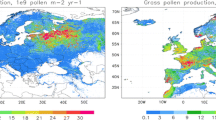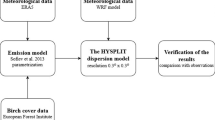Abstract
The paper presents an assessment of birch pollen seasons in Finland and Russia. The re-analysis covered the period from 1994 to 2005 and was focused on suspected long-range transport events that were recorded both in Moscow and at several Finnish sites. In order to trace the origin of airborne pollen before the onset of local pollination, we used both aerobiological and phenological observations combined with forward and adjoint (inverse) dispersion model simulations. It is shown that, although the Moscow region is surrounded by extensive birch forests, it still receives substantial amounts of foreign pollen before local pollination. In the Moscow region, the sources of long-range-transported pollen are in the south and south-west, sometimes even in the east. In Finland, there are frequently cases, before the local flowering season, in which Finnish territory receives Russian pollen; however in the opposite direction, from Finland to the Moscow region, no transport episodes were unequivocally registered. Analysis of the end of the seasons was more problematic, due to contributions to pollen observations from local sources; this results in difficulties in the reliable identification of the long-range transport episodes. Apart from its short-term effects on the pollen seasons, long-range transport can have substantial impacts on the exchange of genetic material within Europe. A quick atmospheric pathway for gene transport can be important for adaptation of plants to a changing climate.













Similar content being viewed by others
References
Achard, F., Mollicone, D., Stibig, H. J., Aksenov, D., Laestadius, L., Li, Z. Y., et al. (2006). Areas of rapid forest-cover change in boreal Eurasia. Forest Ecology and Management, 237, 322–334. doi:10.1016/j.foreco.2006.09.080.
Atkinson, M. D. (1992). Betula pendula Roth (B. verrucosa Ehrh.) and B. pubescens Ehrh. Journal of Ecology, 80, 837–870. doi:10.2307/2260870.
Aylor, D. (2004). Survival of maize (Zea mays) pollen exposed in the atmosphere. Agricultural and Forest Meteorology, 123, 125–133. doi:10.1016/j.agrformet.2003.12.007.
Barnes, C. W., Szabo, L. J., Isard, S. A., Ariatti, A., Tenuta, A. U., Hambleton, S., et al. (2008). Patterns of Phakopsora pachyrhizi spore deposition detected in North America rain and their use to calibrate IAMS soybean rust forecasts in 2007. Phytopathology, 98, 18. doi:10.1094/PHYTO-98-1-0115.
British Aerobiology Federation. (1995). Airborne pollens and spores, a guide to trapping and counting (1st ed.). Harpenden: BAF.
Carter, T. R., Jylhä, K., Perrels, A., Fronzek, S., & Kankaanpää, S. (2005). FINADAPT scenarios for the 21st century: Alternative futures for considering adaptation to climate change in Finland. FINADAPT Working Paper 2, Finnish Environment Institute Mimeographs 332, Helsinki, 42 pp.
Chamberlain, A. C. (1953). Aspects of travel and deposition of aerosols and vapour clouds. A.E.R.E. Harwell, Report 1261, 31 pp.
Corden, J. M., Stach, A., & Milligton, W. (2002). A comparison of Betula pollen season at two European sites; Derby, United Kingdom and Poznan, Poland (1995–1999). Aerobiologia, 18, 53–54. doi:10.1023/A:1014953527763.
Damialis, A., Gioulekas, D., Lazopoulou, C., Balafoutis, C., & Vokou, D. (2004). Transport of airborne pollen into the city of Thessaloniki: The effects of wind direction, speed and persistence. International Journal of Biometeorology, 49, 139–145. doi:10.1007/s00484-004-0229-z.
Erdtman, G. (1937). Pollen grains recorded from the atmosphere over the Atlantic. Meddelanden Göteborgs Botaniska Trädgard, 12, 186–196.
Gregory, H. P. (1945). Dispersal of air-borne spores. Transactions of the British Mycological Society, 28, 26–72.
Häkkinen, R., Linkosalo, T., & Hari, P. (1998). Effects of dormancy completion and the environmental factors on timing of bud burst in Betula pendula. Tree Physiology, 18, 707–712.
Hirst, J. M. (1952). An automatic volumetric spore trap. The Annals of Applied Biology, 39, 257–265. doi:10.1111/j.1744-7348.1952.tb00904.x.
Hjelmroos, M. (1992). Long-distance transport of Betula pollen grains and allergic symptoms. Aerobiologia, 8, 231–236. doi:10.1007/BF02071631.
Käpylä, M., & Penttinen, A. (1981). An evaluation of the microscopical counting methods of the tape in Hirst–Burkard pollen and spore trap. Grana, 20, 131–141.
Kubin, E., Poikolainen, J., Hokkanen, T., Karhu, J., & Pasanen, J. (2004). Field instructions for plant-phenological observations. Finland: Finnish Forest Research Institute, Muhos Research Station.
Latałowa, M., Miętus, M., & Uruska, A. (2002). Seasonal variations in the atmospheric Betula pollen count in Gdańsk (southern Baltic coast) in relation to meteorological parameters. Aerobiologia, 18, 33–43. doi:10.1023/A:1014905611834.
Lindgren, D., Paule, L., Shen, X. H., Yazdani, R., Segerström, U., Wallin, J. E., et al. (1995). Can viable pollen carry Scots pine genes over long distances? Grana, 33, 64–69.
Linkosalo, T. (1999). Regularities and patterns in the spring phenology of some boreal trees. Silva Fennica, 34(4), 237–245.
Luomajoki, A. (1999). Differences in the climatic adaptation of silver birch (Betula pendula) and downy birch (Betula pubescens) in Finland based on male flowering phenology. Acta Forestalia Fennica, 263, Finnish Society of Forest Science.
Mäkinen, Y. (1981). Random sampling in the study of microscopic slides. Reports from the Aerobiology Laboratory of the University of Turku, 5, 27–43.
Matikainen, E., & Rantio-Lehtimäki, A. (2002). Semiquantitative and qualitative analysis of pre-seasonal airborne birch pollen allergens in different particle sizes—background information for allergen reports. Grana, 37, 293–297.
OECD. (2003). Consensus document on the biology of European white birch (Betula pendula Roth.). Series on harmonisation of regulatory oversight in biotechnology (Vol. 28). OECD. http://www.olis.oecd.org/olis/2003doc.nsf/LinkTo/env-jm-mono(2003)12.
Ranta, H., Kubin, E., Siljamo, P., Sofiev, M., Linkosalo, T., Oksanen, A., et al. (2006). Long distance pollen transport cause problems for determining the timing of birch pollen season in Fennoscandia by using phenological observations. Grana, 45, 297–304. doi:10.1080/00173130600984740.
Ranta, H., Sokol, C., Hicks, S., Heino, S., & Kubin, E. How do airborne and deposition pollen samplers reflect the atmospheric dispersal of different pollen types? An example from northern Finland. Grana (in press).
Rantio-Lehtimäki, A. (1994). Short, medium and long range transported airborne particles in viability and antigenicity analyses. Aerobiologia, 10, 175–181. doi:10.1007/BF02459233.
Rousi, M., & Heinonen, J. (2007). Temperature sum accumulation effect on within-population variation and long-term trend in date of bud-burst of European white birch (Betula pendula). Tree Physiology, 25, 201–210.
Rousi, M., & Pusenius, J. (2005). Variations in phenology and growth of European white birch (Betula pendula) clones. Tree Physiology, 25, 201–210.
Sarvas, R. (1952). On the flowering of birch and the quantity of seed crop. Communicationes Instituti Forestalia Fennica, 40, 1–38.
Siljamo, P., Sofiev, M., & Ranta, H. (2007a). An approach to simulation of long-range atmospheric transport of natural allergens: An example of birch pollen. In C. Borrego & A.-L. Norman (Eds.), Air pollution modeling and its application XVII (pp. 331–339). The Neatherlands: Springer.
Siljamo, P., Sofiev, M., Severova, E., Ranta, H., & Polevova, S. (2007b). On influence of long-range transport of pollen grains onto pollinating season. In C. Borrego & E. Renner (Eds.), Air pollution modeling and its application XVIII. Developments in environmental science (Vol. 6, pp. 708–716). Elsevier.
Siljamo, P., Sofiev, M., Ranta, H., Linkosalo, T., Kubin, E., Ahas, R., et al. (2008). Representativeness of point-wise phenological Betula data collected in different parts of Europe. Global Ecology and Biogeography, 17, 489–502. doi:10.1111/j.1466-8238.2008.00383.x.
Skjøth, C. A., Sommer, J., Stach, A., Smith, M., & Brandt, J. (2007). The long-range transport of birch (Betula) pollen from Poland and Germany causes significant pre-season concentration Denmark. Clinical and Experimental Allergy, 37(8), 1204–1212. doi:10.1111/j.1365-2222.2007.02771.x.
Sofiev, M., Siljamo, P., Ranta, H., & Rantio-Lehtimäki, A. (2006a). Towards numerical forecasting of long-range air transport of birch pollen: Theoretical considerations and a feasibility study. International Journal of Biometeorology, 50, 392–402. doi:10.1007/s00484-006-0027-x.
Sofiev, M., Siljamo, P., Valkama, I., Ilvonen, M., & Kukkonen, J. (2006b). A dispersion modelling system SILAM and its evaluation against ETEX data. Atmospheric Environment, 40, 674–685. doi:10.1016/j.atmosenv.2005.09.069.
Sofiev, M., Bousquet, J., Linkosalo, T., Ranta, H., Rantio-Lehtimäki, A., Siljamo, P., & Valovirta, A. (2008a). Pollen, allergies and adaptation, chapter 8. In Burton I, Ebi K, & Hoeppe P (Eds.), Biometeorology for adaptation to climate variability and change: Research Frontiers and Perspectives. Springer.
Sofiev, M., Siljamo, P., Karppinen, A., & Kukkonen, J. (2008b). Air quality forecasting during summer 2006: Forest fires as one of major polluting sources in Europe. In C. Borrego & A. I. Miranda (Eds.), Air pollution modeling and its application XIX. NATO science for peace and security series—C: Environmental security (pp. 305–312). Springer.
Sofiev, M., Siljamo, P., Ranta, H., Linkosalo, T., Oksanen, A., Karppinen, A., & Kukkonen, J. (2008c). From Russia to Iceland: A complex evaluation of a large-scale pollen and chemical air pollution episode during April–May 2006. In P. Comtois & B. Clot (Eds.), Aerobiological monographs. Zurich: MeteoSwiss and the University of Montreal.
Viander, M., & Koivikko, A. (1978). The seasonal symptoms of hyposensitized and untreated hay fever patients in relation to birch pollen counts: Correlation with nasal sensitivity, prick tests and RAST. Clinical Allergy, 8, 387–396. doi:10.1111/j.1365-2222.1978.tb00474.x.
Wallin, J. E., Segerstrom, U., Rosenhall, L., Bergmann, E., & Hjelmroos, M. (1991). Allergic symptoms caused by long-distance transported birch pollen. Grana, 30, 265–268.
Walther, G.-R. (2003). Plants in a warmer world. Perspectives in Plant Ecology, Evolution and Systematics, 6, 169–185. doi:10.1078/1433-8319-00076.
WHO. (2003). Phenology and human health: Allergic disorders (55p). Copenhagen: WHO Regional Office for Europe.
Acknowledgements
The study was performed within the scope of the POLLEN project of the Academy of Finland. The pollen forecasts and re-analyses were also supported by the ESA-PROMOTE Service Element of GMES. The support of the COST Action ES0603 (assessment of production, release, distribution and health impact of allergenic pollen in Europe) is also appreciated.
Author information
Authors and Affiliations
Corresponding author
Rights and permissions
About this article
Cite this article
Siljamo, P., Sofiev, M., Severova, E. et al. Sources, impact and exchange of early-spring birch pollen in the Moscow region and Finland. Aerobiologia 24, 211–230 (2008). https://doi.org/10.1007/s10453-008-9100-8
Received:
Accepted:
Published:
Issue Date:
DOI: https://doi.org/10.1007/s10453-008-9100-8




